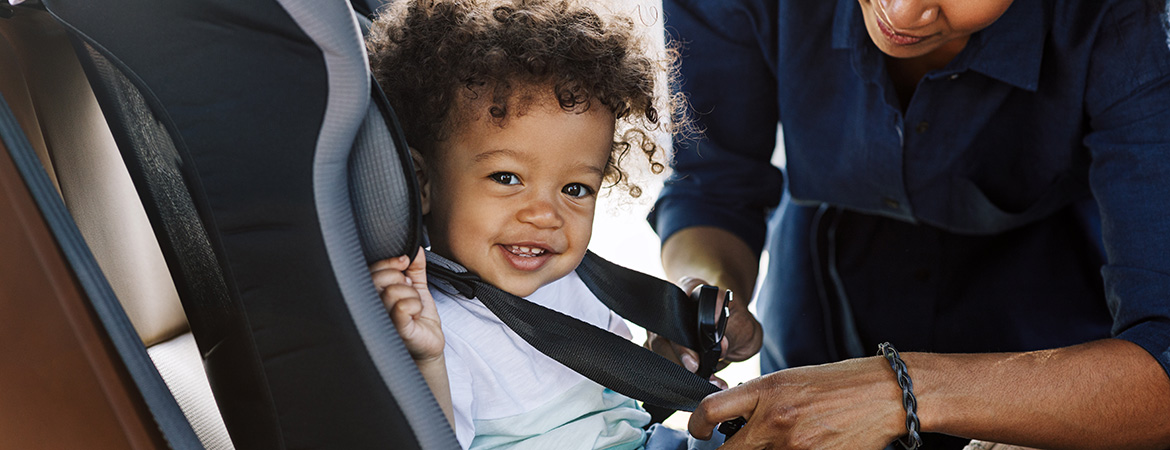A parent's guide to car and booster seats
Parents and caregivers have the ability to make lifesaving differences when buckling young ones in for a trip.

In recent decades, great strides have been made in child passenger safety. Despite these advancements, motor vehicle crashes unfortunately remain a leading cause of death among children in the United States. In 2022, the Insurance Institute for Highway Safety (IIHS) reported that 859 children aged 13 and younger died in motor vehicle crashes in the U.S.
While these numbers are harrowing, children are much safer in cars than they used to be. The number of child passenger deaths has declined by nearly half since 1975, according to the IIHS.
Parents and caregivers have the ability to make lifesaving differences when buckling young ones in for a trip. In a study by the National SAFE KIDS Campaign which examined nearly 38,000 child safety seats and safety belts, more than 80 percent of child restraints were used incorrectly. Having the right equipment is only the first step; it’s also imperative to know how to use it.
Here are some helpful tips for parents and caregivers of small children for proper car seat usage:
- First and foremost, always study the owner’s manual and/or labels on the seat. These materials will ensure proper usage and give you important information about the weight and height requirements.
- Choose the appropriate restraint based on your child’s weight and size. The Centers for Disease Control’s (CDC) recommendations are as follows:
- Birth to ages 2-4: "Infants and toddlers should be buckled in a rear-facing car seat with a harness, in the back seat, until they reach the maximum weight or height limit of their car seat. This offers the best possible protection" (CDC). Note that rear-facing seats should never be placed in the front seat. Front passenger air bags can injure or kill young children in a crash.
- After outgrowing their rear-facing car seat, use a forward-facing car seat until at least age 5: "When children outgrow their rear-facing car seat, they should be buckled in a forward-facing car seat with a harness and a top tether, in the back seat. Children should stay in their forward-facing car seat until they reach the maximum weight or height limit of this seat" (CDC). Kentucky law requires that children forty (40) inches in height or less be properly secured in a child restraint system (car seat) meeting federal safety standards.
- After outgrowing their forward-facing car seat, use a booster seat until the seat belt fits properly: "When children outgrow their forward-facing car seat, they should be buckled in a belt-positioning booster seat with a seat belt, in the back seat, until the seat belt fits properly without a booster seat. A seat belt fits properly when the lap belt is across the upper thighs (not the stomach) and the shoulder belt is across the center of the shoulder and chest (not across the neck or face, and not off the shoulder). This usually occurs when children are between 9 and 12 years old" (CDC). Kentucky law requires that children younger than 8 and between forty (40) inches and fifty-seven (57) inches tall be secured in a booster seat.
- Make sure your child’s car seat is properly installed. Child restraints can be overwhelming and difficult to install. Luckily, there are locations all across Kentucky designated as “car seat inspection stations” where certified technicians will inspect your car seat free of charge and even show you how to correctly install and use it. The National Highway Traffic Safety Administration (NHTSA) has a great car seat inspection location finder. Click here to enter your town’s name and find an inspector near you.
- Thousands of car seats are affected by safety recalls each year. Register your car seat with the manufacturer to make sure you receive important updates about safety notices or recalls. You can also review the NHTSA’s comprehensive list of recalls, investigations, and complaints regarding your specific car seat here.
Front airbags are designed to protect average-sized adults and could cause serious injuries to children. Those who have graduated from their booster seat should be buckled in the back seat for the best possible protection. The CDC recommends buckling children in the middle of the back seat as it is the safest spot in the vehicle.
Remember, properly buckling up is the single most effective thing you can do to ensure a healthy and happy future for you and your travel companions.
>> We want you to be safe out there on the road… but accidents still happen.
At Kentucky Farm Bureau, we’ve got agents in all 120 counties. Click to find one near you.
Check out the video below and subscribe to our YouTube channel for more Tools and Resources.
